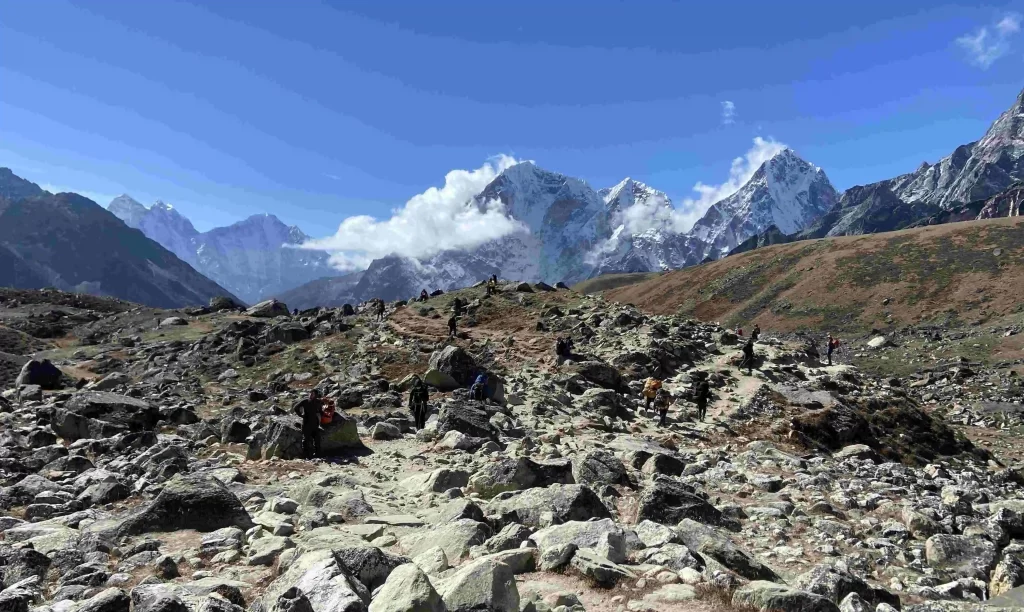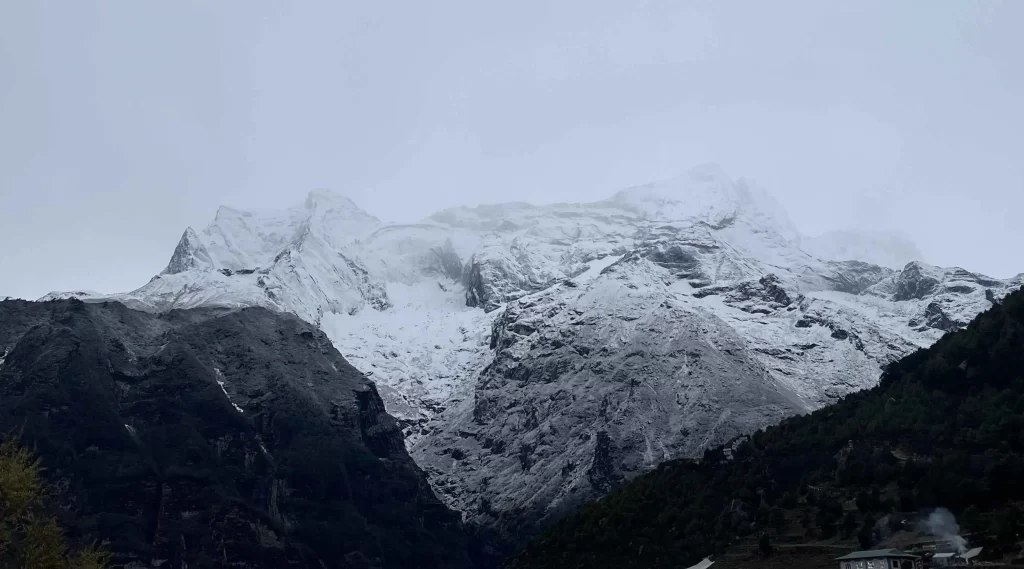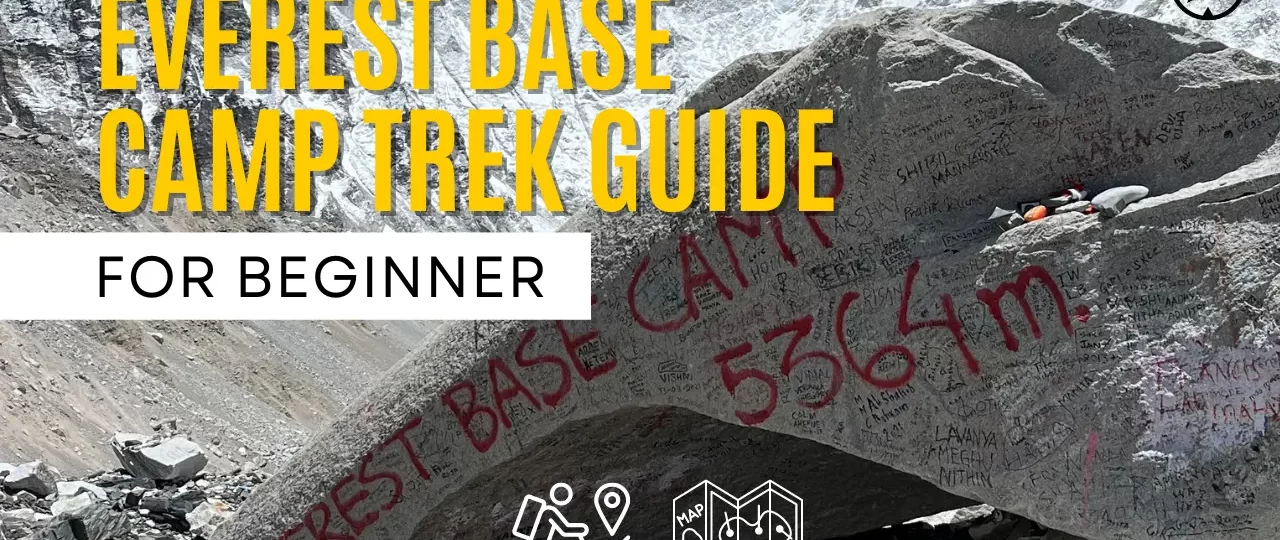Top 10 Beginner Guide to the Everest Base Camp Trek
Are you a beginner trekker who wants to do the Everest Base Camp Trek?
Picture this: You find yourself in the heart of the Himalayas, starting your trek in the quaint town of Lukla, notorious for its thrilling airstrip that challenges even the most seasoned pilots. From here, a trail unfolds, guiding you through vibrant Sherpa villages, enchanting rhododendron forests, and high-altitude landscapes, culminating in the grandeur of the Everest Base Camp.
As you ascend, the air becomes thinner, and the landscape transforms. The Everest Base Camp itself sits at a jaw-dropping 5,364 meters (17,598 feet) above sea level. But the trek isn’t just about reaching this iconic destination; it’s a symphony of altitudes, with the crescendo being the Kala Patthar viewpoint at 5,545 meters (18,192 feet), offering a panoramic dance of Everest and its neighboring peaks.
As you embark on the thrilling journey to the renowned Everest Base Camp, I’ve curated the top 10 tips/guides tailored for beginners like you. Additionally, I’ll delve into various aspects of the trek to further enrich your understanding and preparation for this iconic adventure.
But before that let’s know a bit about the EBC trek.
About the Everest Base Camp Trek
Location: Solu Khumbu, East Nepal
Duration: 14 Days
Elevation: 5,364m
Difficulty: Moderate/Challenging
Total Length: 130 KM
Starting & Ending Point: Lukla
Transportation: Lukla Flight via Kathmandu (Dec-Feb and June-Sep) | Ramechhap (March-May and Oct-Nov)
Accommodations: Hotel, Lodge, and Teahouses
Major Stops: Phakding, Namche Bazaar, Tyangboche, Dingboche, Lobuche, Gorakshep, and Pheriche
Internet and WIFI Services: Available
Everest Base Camp Trek Facts and Highlights:
Highest Mount Everest: The undisputed star of the show, Mount Everest, stands tall at 8,848 meters (29,029 feet), casting its spell over the entire trek. Every step you take brings you closer to the allure of the world’s highest peak, building anticipation until Everest reveals itself in all its glory.
Warm Sherpa Culture: Beyond the landscapes, the Everest Base Camp trek is a cultural odyssey. The Sherpa people, with their warm hospitality, welcome you into a world where tradition and modernity harmonize. Monasteries perched on hillsides, prayer wheels spinning in the breeze – every encounter is a brushstroke in the vibrant canvas of Sherpa culture.
Staying at Tea Houses and Lodges: Along the trail, rustic tea houses and lodges become your havens. Imagine cozying up by a fireplace, swapping stories with fellow trekkers, and relishing hearty meals that replenish your energy for the journey ahead. These stops are not just resting places but vibrant hubs of camaraderie.
Witnessing Flora and Fauna: Traverse diverse ecosystems, from lush greenery at lower altitudes to the stark beauty of the alpine region. Keep your eyes peeled for Himalayan wildlife, from the elusive snow leopard to the agile Himalayan tahr, creating a wildlife spectacle against the backdrop of breathtaking scenery.
Spiritual Retreats: Visit ancient monasteries like Tengboche, where the spiritual aura transcends the physical realm. The air is infused with centuries-old prayers, and the views from these spiritual retreats provide a breathtaking perspective of the surrounding peaks.
Taking Challenges and Rewards: The Everest Base Camp trek is not just a physical challenge; it’s a profound journey of self-discovery. The challenges of high-altitude trekking are met with the unmatched reward of witnessing the sunrise over Everest, standing at the iconic Base Camp, and conquering the summit of Kala Patthar, each moment etched in the fabric of your Everest tale.
Itinerary of Everest Base Camp for Beginners
- Day 01: Arrival at Tribhuvan International Airport in Kathmandu (1400m/4,593ft)
- Day 02: Fly to Lukla from Kathmandu or Ramechhap and Trek to Phakding (2610m/8,563ft) – 3 hours
- Day 03: Trek to Namche Bazar (3440m/11,286ft) from Phakding – 6 hours
- Day 04: Rest day at Namche Bazar for acclimatization / Day Hike
- Day 05: Trek to Tengboche (3867m/12,687ft) – 6 hours
- Day 06: Trek to Dingboche (4410m/14,468ft) – 6 hours
- Day 07: Rest day at Dingboche for acclimatization / Day Hike
- Day 08: Trek to Lobuche (4910m/16,109ft) – 5 hours
- Day 09: Trek to Everest Base Camp (5364m/17,598ft) via Gorekshep and trek back to Gorekshep (5164m/16,942ft) – 7 hours
- Day 10: Hike to Kalapatthar (5545m/18,192ft) and trek back to Pheriche (4220m/13,845ft) – 7 hours
- Day 11: Trek back to Namche Bazar (3440m/11,286ft) – 7 hours
- Day 12: Trek to Lukla (2860m/9,384ft) – 7 hours
- Day 13: Fly back to Kathmandu (1400m) or Ramechhap (1,218m)
- Day 14: Departure from Kathmandu (1400m)
The above itinerary is a classic EBC trek itinerary that is suitable for both beginner and seasoned trekkers.
Now that you know the basics about the Everest Base Camp trek, here are the 10 beginner guide to the Everest Base Camp Trek you should know before embarking on this legendary trek.
10 Beginner Guide to the Everest Base Camp Trek
1. Physical Preparation:
Before embarking on the Everest Base Camp trek, it’s crucial to acknowledge the physical demands of the journey. Begin your preparation well in advance to build endurance, strength, and stamina. Why? Because you have to walk 5-7 hours on average throughout the whole trek. The trails consist of rocky and rugged paths along with the constant uphill and downhill.
That’s why incorporate a comprehensive fitness regimen that includes cardiovascular exercises like hiking, running, or cycling, complemented by strength training to condition the muscles that will be engaged during the trek. Consistency is key – gradually increase the intensity and duration of your workouts. This preparatory phase not only readies your body for the challenging trek but also enhances your overall enjoyment of the breathtaking landscapes along the way.

2. Acclimatization:
Altitude sickness is a real concern when trekking to higher elevations. And, Everest Base Camp trek is the high altitude trek. During this whole trek, you will gain a maximum altitude of 5,545 meters at Kalapatthar. Additionally, as you ascend to higher elevations the level of oxygen in the air decreases, making the trek more challenging and making your body prone to altitude sickness.
It’s important to plan your itinerary with acclimatization days strategically placed to allow your body to adjust to the reduced oxygen levels gradually. Rushing the ascent increases the risk of altitude-related issues, such as headaches, nausea, and fatigue. Adequate acclimatization ensures a safer and more enjoyable journey, allowing you to fully appreciate the awe-inspiring surroundings of the Everest region.
Normally two days are allocated for the acclimatization process which is at Namche Bazaar (3440m) and Dingboche (4410m).
3. Proper Gear:
Your choice of gear can significantly impact your comfort and safety during the trek. So, invest in high-quality, comfortable hiking boots with proper ankle support to navigate varied terrains. Dressing in layers is essential to adapt to the ever-changing temperatures along the route. Ensure you have a warm and waterproof jacket, insulated gloves, glasses, and a hat to shield against the cold. A well-fitted and durable backpack is indispensable – choose one that distributes weight evenly to avoid unnecessary strain during long days of trekking.
Furthermore, you can add the gear or equipment as per your need. But remember not to overload your backpack as only 15 kg of total weight (10kg luggage and 5 kg hand carry) is allowed on the Lukla flight.
4. Hydration and Nutrition:
Hydration and nutrition play pivotal roles in sustaining your energy levels throughout the trek. The high-altitude environment can lead to increased fluid loss and a higher metabolism, making it crucial to drink plenty of water. Carry water purification tablets or a reliable water filter to ensure a safe water supply. When it comes to food, maintain a well-balanced diet rich in carbohydrates, proteins, and fats. Pack energy-boosting snacks and stay mindful of your body’s nutritional needs to enhance your trekking performance.
One thing I would suggest is to avoid meat (fresh meats are not available) and caffeine throughout the whole trek as it can hamper your body’s health.
5. Travel Insurance:
Travel insurance is a non-negotiable aspect of any adventure, particularly one involving high-altitude trekking. Ensure your insurance policy covers the specific activities and altitudes of the Everest Base Camp trek. Emergency evacuation coverage is paramount, considering the remote locations and potential challenges associated with mountain rescues. Prioritize obtaining comprehensive coverage to safeguard against unforeseen circumstances, providing peace of mind as you embark on this extraordinary journey.
Know more about the EBC Trek Insurance here in detail.
6. Local Culture and Etiquette:
The Everest region is not only a natural marvel but also home to the resilient Sherpa people and their rich cultural heritage. Respecting local customs and traditions is integral to fostering positive interactions and creating a harmonious trekking experience. Take the time to familiarize yourself with basic Nepali phrases – a small effort that can go a long way in building connections with the locals. Embrace the opportunity to learn about their way of life, and approach the journey with cultural sensitivity, enhancing the overall cultural tapestry of your trek.
7. Pack Wisely:
Efficient packing is an art that can significantly enhance your trekking experience. While it’s tempting to bring along every comfort, a lighter backpack contributes to a more enjoyable journey. Prioritize essentials such as a well-stocked first aid kit, sunscreen, lip balm, and a high-quality sleeping bag suitable for the expected temperatures. Choose versatile clothing that can be layered to adapt to changing weather conditions. Streamlining your packing list ensures you have everything you need without the unnecessary burden of excess weight.
8. Permits and Documentation:
Navigating the bureaucratic requirements is a crucial step in preparing for the Everest Base Camp trek. Keep a photocopy of your passport, permits, and emergency contact information securely stored in your backpack. This not only facilitates the permit-check process but also serves as a precautionary measure in case of unforeseen circumstances, providing a sense of security as you venture into the Himalayan terrain.
As for the permits, you will need two different kinds of permits: Sagarmatha National Park and Local Khumbu Municipality which you can get at the Lukla counter.
9. Guides and Local Support:
While some trekkers opt for a solo adventure, considering the services of a local guide and/or porter can significantly enhance your experience. Local guides possess invaluable knowledge of the terrain, and cultural insights, and can provide essential support in navigating the trek safely. Porters can help alleviate the physical strain of carrying a heavy backpack, allowing you to focus on absorbing the beauty of your surroundings. Engaging with local support not only contributes to the local economy but also fosters a deeper connection with the community.
10. Weather Awareness:
The weather in the Himalayas can be unpredictable, ranging from bright sunshine to sudden snowstorms. Dressing appropriately is essential to navigate these variations comfortably. Opt for a layered clothing approach that allows you to adjust to temperature changes easily. Keep a keen eye on weather forecasts before and during the trek, allowing for flexibility in your schedule to accommodate any unexpected weather-related alterations. Staying informed and prepared for varying weather conditions ensures a smoother and more enjoyable trekking experience.

Additional Things To Consider
Pre-book Teahouses/Lodges:
In the hustle and bustle of peak trekking seasons (Spring and Autumn), securing a cozy spot in teahouses and lodges becomes a strategic move. Consider pre-booking accommodations, especially in hotspots like Namche Bazaar and Gorak Shep, ensuring a comfortable night’s rest after a day of adventure.
ATMs and Cash:
While Lukla and Namche Bazaar boast ATMs, it’s wise to carry sufficient cash for the entire trek. ATM availability might be patchy, and some places may prefer the crisp touch of banknotes. Ensure your currency is in friendly denominations for hassle-free transactions.
Communication:
Don’t expect seamless internet or mobile network connectivity in the Himalayan hinterlands. Keep your loved ones informed about potential communication gaps, and consider snagging a local SIM card in Kathmandu for those crucial emergency calls.
Pack Snacks:
Satisfy those on-the-go cravings by stashing a variety of snacks in your backpack. Energy bars, nuts, and dried fruits offer a quick energy fix between meals, ensuring you stay fueled during the exhilarating trekking stretches.
Garbage Disposal:
Become a steward of the environment by carrying a compact trash bag. Responsible trekking involves proper garbage disposal, and preserving the pristine beauty of the Himalayas for generations to come.
Footwear Considerations:
While your trusty hiking boots are non-negotiable, don’t forget to pack lighter alternatives like sandals or comfy shoes for evenings at teahouses. Give your feet a break from the rugged terrains, and let them breathe.
Photography Gear:
Capture the magic of the Everest region with a stellar camera or smartphone. Ensure your camera batteries are fully juiced, and bring extra memory cards to accommodate the breathtaking vistas. A portable charger is a smart addition for those rare charging opportunities.
Trekking Poles:
Introduce your knees to the joys of trekking poles. These trusty companions reduce strain and provide stability, particularly during descents or tricky terrains. A little extra support can make a world of difference.
Respect Local Customs:
Immerse yourself in the rich tapestry of local customs and traditions. Seek permission before capturing those Insta-worthy moments, especially in villages. This is your chance to engage with the locals respectfully and uncover the layers of their captivating way of life.
Stay Hydrated:
Don’t let dehydration dampen your spirits. Sip water regularly, even if you don’t feel parched. A reusable water bottle and a hydration system make staying hydrated a breeze while trekking through the stunning landscapes.
Rest Days:
Treat yourself to well-deserved rest days strategically placed in your itinerary. These breaks aren’t just about catching your breath; they offer crucial acclimatization and allow your body to recover. Utilize this time to explore nearby attractions or simply soak in the breathtaking surroundings.
Is Everest Base Camp Trek good for beginners?
Yes, the Everest Base Camp trek is considered suitable for beginners with a reasonable level of fitness. Adequate preparation, including cardiovascular exercises and strength training, is essential. The trek can be challenging, but a well-paced itinerary and proper acclimatization make it accessible to enthusiasts with varying levels of experience.
How should beginners train for the Everest Base Camp trek?
Beginners should focus on a well-rounded fitness regimen, including cardiovascular exercises such as hiking, running, or cycling to build endurance. Strength training for leg muscles and core stability is crucial. Gradual intensity progression in workouts helps prepare the body for the physical demands of the trek.
Can beginners do the solo trek to EBC?
While it’s possible for beginners to do the Everest Base Camp trek independently, it’s generally advisable, especially for first-timers, to consider guided treks. Experienced guides provide valuable insights, assist with logistics, and enhance safety. For those more experienced and confident in their abilities, solo treks are feasible with thorough preparation and a keen awareness of the challenges involved.
In conclusion, embarking on the Everest Base Camp trek is a journey of a lifetime that demands both physical preparation and mental readiness. Each of these tips contributes to a comprehensive guide aimed at maximizing your safety, comfort, and enjoyment throughout this extraordinary adventure. I hope this beginner guide to the Everest Base Camp Trek will help you a lot. May your trek be filled with awe-inspiring moments and a profound connection with the breathtaking landscapes of the Everest region. Happy trekking!



